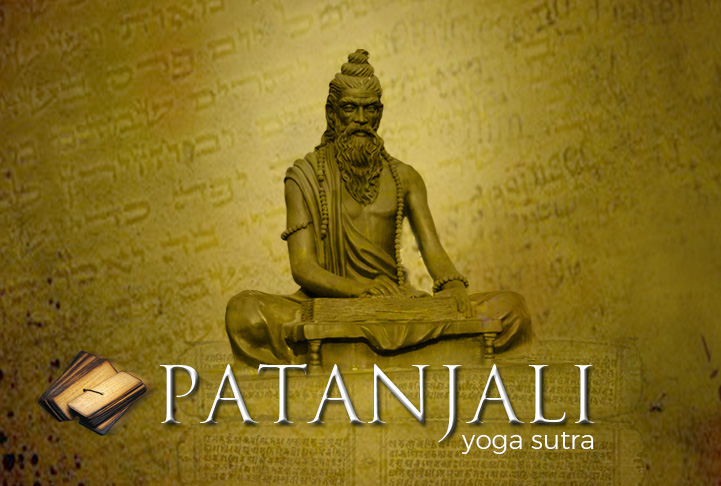In Indian mythology there is a beautiful legend about the sage Patanjali, who is considered to be the father of Yoga. Patanjali’s mother, Gonika, was praying to the Sun God Surya for a worthy son. Devotedly she took a handful of water to offer it to the Sun God in her meditation upon him. Suddenly, a tiny snake appeared in her hand and began to take on human form. A man emerged who asked her to take him as her son. Gonika did and named him Patanjali – meaning Pata, fallen, and Anjali, oblation or ‘hands folded in prayer’.
At the same time that Gonika was praying to the Sun God for a worthy son, the Lord of Serpents, Adisesa, was sitting in deep meditation, seeking as whose son he was to be incarnated. He had been told by Lord Vishnu that Lord Siva would grace him with the wisdom to write books on grammar, and that he would also be able to perfect the art of dance, which Adisesa was mesmerized by. In his meditation Adisesa saw Gonika and realized she would be the mother he was seeking for.
So being reincarnated as Patanjali, Adisesa took up Lord Siva’s command, and began writing books in Sanskrit not only on language and grammar, but also on Ayurveda, the science of life and health, and on a man’s mental and spiritual development, which comprise The Yoga Sutras. These three works together speak about a man’s evolution as a whole; in thought, speech and action, and taken together are called yoga darsana; darsana meaning ‘vision of the soul’ or ‘mirror’.
Did Patanjali really live?[1]
Aside from the Indian myth about the Lord of Serpent’s reincarnation, scholars seem to generally agree that Patanjali did indeed live and work as scholar, or inspired seer, as he is also called by other Yoga masters. Since ancient Sanskrit texts are very difficult to date, it is almost impossible to say when he really lived and wrote The Yoga Sutras, and his other works. Based on the content of the Yoga Sutras many scholars date the text to shortly after the turn of the common era and place it between the 1st and 2nd century C.E. Still other scholars place it as early as several centuries before the common era. Thus, the life of Patanjali and his works can be placed somewhere in between the last 2500 and 1500 years, which is a pretty broad range. Nevertheless, this inexactness of dating Patanjali’s work does not take away from his authority and authenticity on Yoga. It is further believed, that at first Patanjali’s teachings were transmitted orally, and the first commentary was written down by Vyasa in the 5thcentury.
Yet, whether Patanjali’s teachings were first transmitted orally and written down later, and irrespective of when they really date back to, its message is still as relevant today as it was for the yogis seeking self-realization in ancient India. The significance of Patanjali’s teaching is summed up by BKS Iyengar, as “[…] the most important message of this inspired seer, coming to us through the ages, is that the real purpose of our life is to cross the ocean of illusion from the shore of worldly pleasures to the other shore of emancipation and eternal bliss”.[2]
The Yoga Sutras[3]
The Yoga Sutras are a collection of 196 aphorisms that serve as a philosophical guidebook for most of the Yoga that is practiced today. The Sanskrit word Sutra means thread and in this context the sutra means the individual verses Patanjali writes. Thus, one can think of them as being connected like pearls on a thread.
The Yoga Sutras are divided into four chapters (padas):
1 – Samadhi Pada, 2 – Sadhana Pada, 3 – Vibhuti Pada, and 4 – Kaivalya Pada
- Samadhi Pada (on contemplation)
The first chapter begins with an introduction to Yoga and what one can hope to attain through practicing Yoga. In one of the most well-known Sutras 1.2. Patanjali defines Yoga as “yogah citta vrtti nirodha” – Yoga is the stilling of the fluctuations of the mind (1.2.). It can be said that Patanjali opens with this verse to draw in exactly those readers who are already on the path of seeking Self-realization. This verse can also be seen as an introduction of what is to follow. Sutras 1.3. and 1.4. describe the difference between what is to be experienced when Yoga, Samadhi is attained (1.3.) and when it is not (1.4.). The rest of the chapter is laid out in the following way:
- Sutras 1.5. – 1.11.: A description of the movements of consciousness and their causes. (Sometimes also referred to as the “colouring” or “shading” of the thoughts).
- Sutras 1.12. – 1.16.: The importance of abhyasa– practice, and vairagya– non-attachment. Even though we practice to attain the goal of yoga, it is important to become unattached to the outcome. One could say we practice for the sake of practicing and know where it can lead us but we know not be invested in the “goal”, in the outcome.
- Sutras 1.17. – 1.18.: Two types of Samadhi; samprajnata samadhi – which depends on deep concentrating on an object and asamprajnata samadhi – without an object, also called seedless Samadhi.
- Sutras 1.19. – 1.22.: Here Patanjali describes the effects of the effort and the commitment to one’s sadhana, spiritual practice, and lays out also different types of students.
- Sutras 1.23. – 1.29.: In these Sutras Patanjali reveals that one may have a direct experience of Samadhi through devotion to and surrendering to Isvara, God. This surrender of one’s ego, aspirations, pains, pleasures, desires, joys and achievements is also the way of Bhakti Yoga described in The Baghavad Gita. Patanjali describes that the direct route to Isvara is the chanting of the syllable AUM (see section 6. for the meaning of AUM).
- Sutras 1.30. – 1.39.: The obstacles on the spiritual path and how to overcome them. The obstacles can be surpassed by practicing the eightfold path (Ashtanga Path), which Patanjali introduces here in Sutras 1.33. – 1.39. These Sutras refer to each limb of the eightfold path, and are described in depth in the Sadhana Pada and Vibuthi Pada. There are nine obstacles, which can be divided into four areas: physical, mental, intellectual and spiritual. The physical obstacles are disease and lack of interest; the mental ones are lingering doubts, pride, idleness and sense gratification; the intellectual one is living in delusion and the two spiritual obstacles are lack of perseverance and spiritual pride or stagnation. Besides those there are four more conditions that disturb the citta (mind) and therefore impede practice. These are: duhkha– grief or sorrow, daurmanasya– despair or mental pain, angamejayatva – unsteadiness of the body and svasaprasvasah– unevenness of the breath.
The solution Patanjali offers for these nine obstacles and four disturbances is simple:
tatpratisedharham ekatattva abhyasah – Adherence to single-minded effort prevents these impediments (1.32.) This means basically that meditation in various forms, which is the single-minded effort, helps to overcome these obstacles and is the reason one would practice the first seven limbs of the Ashtanga path, which are introduced at this point. 1.33. relates to Yamas, Niyamas and Asanas, 1.34. to Pranayama, 1.35 to Pratyahara, 1.36.,1.37., and 1.38 to Dharana, and 1.39 to Dhyana.
- Sutra 1.40. – 1.51.: Here the results of the practice are described.
[1]See the Internet Encyclopedia of Philosophy http://www.iep.utm.edu/yoga/
[2]BKS Iyengar. Light on the Yoga Sutras of Patanjali, pg. 274
[3]There are many different translations of the Yoga Sutras. The ones used here in the following descriptions are the ones by BKS Iyengar in his work Light on the Yoga Sutras of Patanjali
by Carina Hilmar and Beate McLatchie

